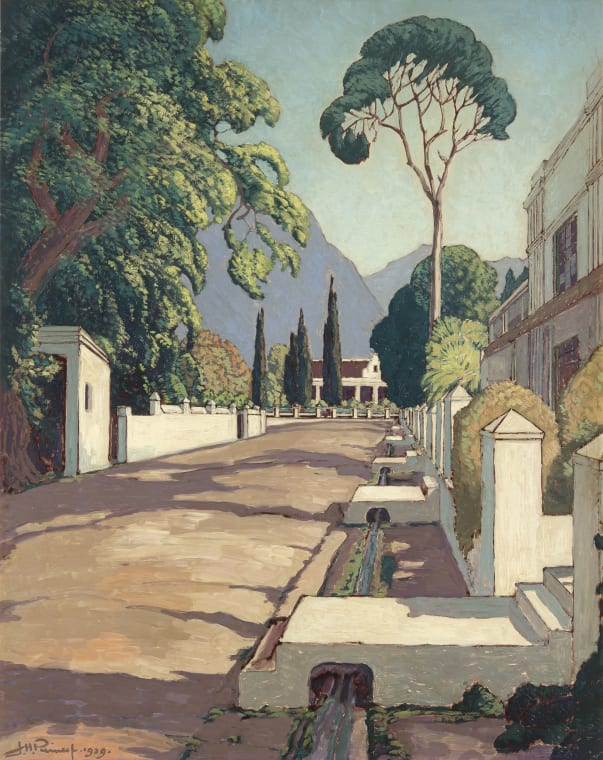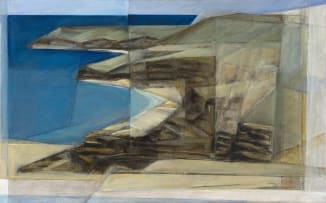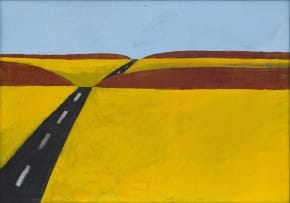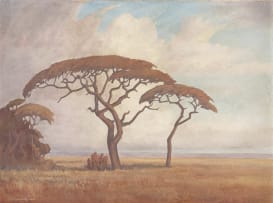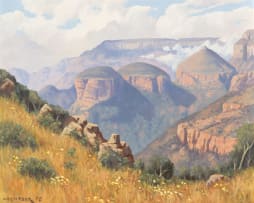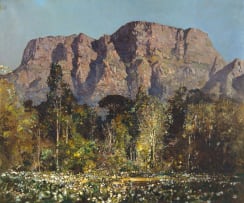Curatorial Voices: African Landscapes, Past and Present
Live Virtual Auction, 19 February 2024
Curatorial Voices: African Landscapes, Past and Present
About the SessionFrom Thomas Baines to Jake Aikman, Curatorial Voices: African Landscapes, Past and Present will showcase art by pioneering modernist and trailblazing contemporary artists, spanning 175 years of visual landscape painting on the African continent. This comprehensive auction reveals a nuanced understanding of the diverse cultural, historical, and environmental contexts that have shaped artistic representations of the landscape. Through an examination of various themes, the auction seeks to engage viewers in a dialogue that transcends time and space, connecting past representations to contemporary perspectives. The auction attempts to engage with the diversity of artists that have shaped and continue to shape the depiction of Africa through time.
The auction invites viewers on a captivating journey through the artistic expressions that mirror the multifaceted nature of African terrain. Through meticulous curation and insightful analysis, the catalogue aspires to be a valuable resource for scholars, art enthusiasts and anyone eager to embark on a thought-provoking exploration of Africa’s rich and complex artistic heritage.
Curatorial Voices
Recognising the dynamic discourse surrounding African Landscape, both past and present, the auction features texts by invited contemporary curators responding to the auction selection and themes. As external voices, they provide critical insights into the complexities of the landscape theme. By amplifying these contemporary perspectives, the exhibition seeks to bridge the gap between traditional representations and the ever-evolving discourse on the role of African art within the global art market.
Azza Satti, Independent Curator, Kenya
Azu Nwagbogu, Founder and Director of the African Artists’ Foundation (AAF), Nigeria
Camilla van Hoogstraten, Head of Sales, Latitudes Online
Ugoma Ebilah, Curator, Gallerist & Founder of Bloom Art
Nkgopoleng Moloi, Independent Curator, South Africa
Incl. Buyer's Premium & VAT
About this Item
signed and dated 1929
Notes
The present lot is accompanied by a photocopy of the exhibition catalogue from the Glen's Music Rooms' Exhibition of Paintings by J H Pierneef, where the painting was probably purchased (cat. no. 32 or 33 with the title Street in Tulbagh), along with an exhibition brochure and poster from A Space for Landscape: The Work of J H Pierneef held at Standard Bank Gallery, Johannesburg.
Pierneef was an ardent champion of the possibilities of an authentic South African visual identity. He gave expression to his activism in various public talks, notably about San rock art and vernacular architecture. His insights drew on first-hand observation. Pierneef first visited the Cape in 1916 with Erich Mayer to view original tracings of San rock art made by geologist George Stow. Pierneef later abandoned his interest in rock art in favour of researching and depicting vernacular settler architecture. Buildings in the Cape Dutch style came to feature prominently in his extensive output of Cape scenes.
The cultural zeitgeist of Union-era South Africa played an important role in directing Pierneef's flair as a draughtsman towards the subject of Cape architectural heritage. Political leaders, industrialists, architects, writers, and even artists - among them Alys Fane Trotter, Arthur Elliott and Robert Gwelo Goodman - saw in the architecture of the old Cape a powerful national symbol. Writing of the Cape Dutch Revivalism that gripped earlier 20th-century South Africa, historian Peter Merrington states: 'The Cape homesteads represented the vernacular essence of establishment, progress, vision, cultivation: in sum, the will to plant, build and define a nation.'1
Pierneef was drawn into this national project in 1918 with a commission from Lady Mildred Buxton, the wife of Governor-General Sydney Buxton, to portray architect Sir Herbert Baker's Government House, a Cape revivalist-style residence in Pretoria. Following his first exhibitions in the Cape in 1921, Pierneef frequently portrayed the region's architecture. He initially focussed on the farming settlements at Constantia and Stellenbosch, but later extended his range to encompass Tulbagh. Its appeal remains obvious. Located at the northern end of the Klein Berg River, Tulbagh is gently encircled on three sides by mountains and, until a devastating earthquake in 1969, featured numerous extant buildings from the 1700s.
Painted in the year Pierneef received his career-defining Johannesburg Station Panels commission, this fine street scene skilfully fuses three essential subjects from the artist's output -heritage architecture, trees and mountains - into a satisfying unity. The view looks north towards the old parsonage and beyond it the Groot Winterhoek range. The parsonage was constructed in the mid-1700s in the High Cape Dutch style, although, by the 1920s, it included embellishments such as a veranda with columns.2 The view encompasses, at right, De Wet House (now Mon Bijou), which is ascribed to the Cape Palladian architect Louis-Michel Thibault and is considered an imitation of French architect Ange-Jacques Gabriel's Petit Trianon at Versailles.3
Sir Alfred Beit, son of mining entrepreneur Otto Beit, acquired the house on the advice of architectural historian Dr Mary Cook. Cook famously owned Ballotina, also by Thibault; the whitewashed wall at left indicates this storied home's boundary. Cook advised on Tulbagh's restoration after 1969. The owner of this lot assisted her in this activity. Church Street, now tarred, essentially looks the same as Pierneef found it a century ago. His naturalistic approach in this lot is, however, characterised by artistic license. Foreshortening compresses the distance between the architectural landmarks. The verticality of the trees and mountains is also slightly accentuated. Commenting on Pierneef's widely admired rhetorical style in 1948, A C Bouman light-heartedly remarked, 'the landscape, if it could speak, would certainly sometimes protest'.4 The protest would not take issue with Pierneef's sincerity of mission and obvious virtuosity.
1.Peter Merrington (1998/99) 'Heritage, Pageantry and Archivism: Creed systems and tropes of public history in imperial South Africa, circa 1910' in Kronos, Vol. 25, Pre-millennium issue, page 147.
2. Telephone interview with architect Anthony Clayton, 11 December 2023.
3. Peter Merrington (2006) 'Cape Dutch Tongaat: A Case Study' in Heritage, Journal of Southern African Studies, Vol. 32.4, page 694.
4. A C Bouman (1948) Painters of South Africa, Cape Town, HAUM, page 25.
Provenance
It is believed that the present lot which was acquired by the current owner's grandfather, a collector of Pierneef paintings, was purchased at Exhibition of Pictures by JH Pierneef at Glen's Music Rooms, Church Street, Pretoria, in 1930. It has been in the same family for more than 90 years.
Exhibited
Standard Bank Gallery, Johannesburg, A Space for Landscape: The Work of J H Pierneef, 8 July to 12 September 2015.
Literature
Wilhelm van Rensburg (2015) A Space for Landscape: The Work of J H Pierneef, exhibition catalogue, Johannesburg: Standard Bank, illustrated in colour on page 87.
View all Jacob Hendrik Pierneef lots for sale in this auction
